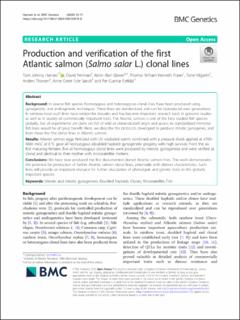| dc.contributor.author | Hansen, Tom Johnny | |
| dc.contributor.author | Penman, David J. | |
| dc.contributor.author | Glover, Kevin | |
| dc.contributor.author | Fraser, Thomas | |
| dc.contributor.author | Vågseth, Tone | |
| dc.contributor.author | Thorsen, Anders | |
| dc.contributor.author | Sørvik, Anne Grete Eide | |
| dc.contributor.author | Fjelldal, Per Gunnar | |
| dc.date.accessioned | 2021-03-24T14:23:04Z | |
| dc.date.available | 2021-03-24T14:23:04Z | |
| dc.date.created | 2020-07-24T14:52:53Z | |
| dc.date.issued | 2020 | |
| dc.Published | BMC Genetics. 2020, 21 . | |
| dc.identifier.issn | 1471-2156 | |
| dc.identifier.uri | https://hdl.handle.net/11250/2735332 | |
| dc.description.abstract | Background
In several fish species homozygous and heterozygous clonal lines have been produced using gynogenetic and androgenetic techniques. These lines are standardized and can be reproduced over generations. In rainbow trout such lines have existed for decades and has become important research tools in genome studies as well as in studies of commercially important traits. The Atlantic salmon is one of the best studied fish species globally, but all experiments are done on fish of wild or domesticated origin and access to standardized immortal fish lines would be of great benefit. Here, we describe the protocols developed to produce mitotic gynogenes, and from these the first clonal lines in Atlantic salmon.
Results
Atlantic salmon eggs fertilized with UV irradiated sperm combined with a pressure shock applied at 4700–4800 minC at 8 °C gave all homozygous (doubled haploid) gynogenetic progeny with high survival. From the six first maturing females, five all homozygous clonal lines were produced by meiotic gynogenesis and were verified as clonal and identical to their mother with microsatellite markers.
Conclusions
We have now produced the first documented cloned Atlantic salmon lines. This work demonstrates the potential for production of further Atlantic salmon clonal lines, potentially with distinct characteristics. Such lines will provide an important resource for further elucidation of phenotypic and genetic traits in this globally important species. | en_US |
| dc.language.iso | eng | en_US |
| dc.publisher | BMC | en_US |
| dc.rights | Navngivelse 4.0 Internasjonal | * |
| dc.rights.uri | http://creativecommons.org/licenses/by/4.0/deed.no | * |
| dc.title | Production and verification of the first Atlantic salmon (Salmo salar L.) clonal lines | en_US |
| dc.type | Journal article | en_US |
| dc.type | Peer reviewed | en_US |
| dc.description.version | publishedVersion | en_US |
| dc.rights.holder | Copyright The Author(s). 2020 | en_US |
| dc.source.articlenumber | 71 | en_US |
| cristin.ispublished | true | |
| cristin.fulltext | original | |
| cristin.qualitycode | 1 | |
| dc.identifier.doi | 10.1186/s12863-020-00878-8 | |
| dc.identifier.cristin | 1820452 | |
| dc.source.journal | BMC Genetics | en_US |
| dc.source.40 | 21 | |
| dc.identifier.citation | BMC Genetics. 2020, 21, 71. | en_US |
| dc.source.volume | 21 | en_US |

